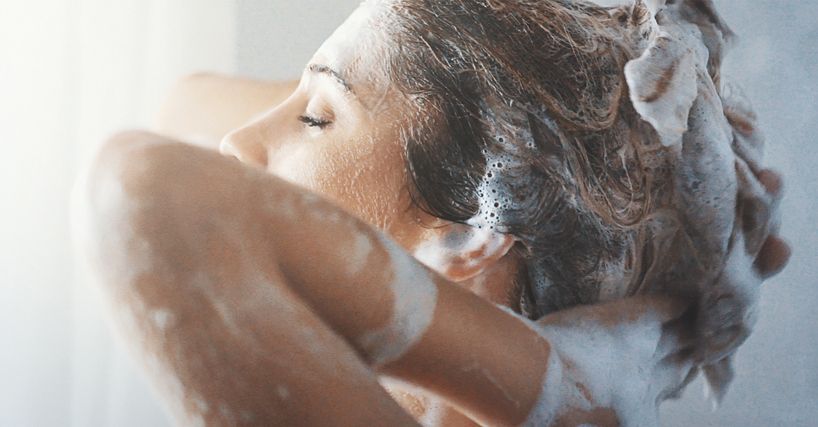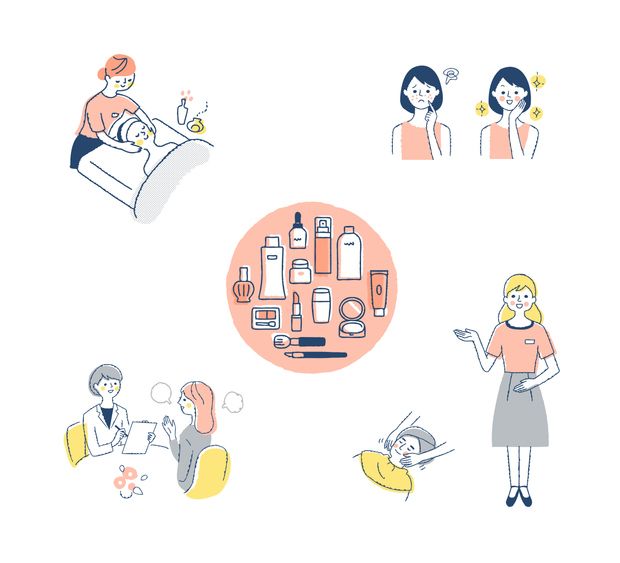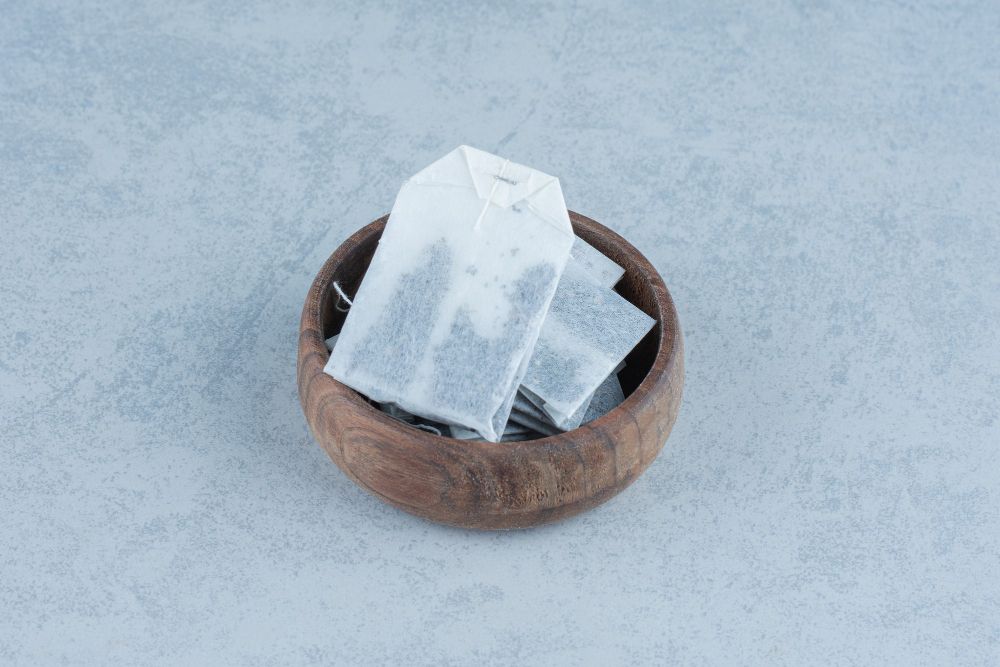
Book Now to Experience
Acne Treatment
1 Minute Self-Registration
Date should not be before minimal date
Author: Puteri Fikri|Updated: 23 July 2024
The excess oil, called sebum, is produced because the skin is dry. Thus the skin is mistaken to produce more healthy fats to replace the insufficient moisture of the skin. With the production of this excess oil, outbreaks of lesions will occur. Acne will mainly be on the face but can also appear on the back, chest or shoulders. Acne is an inflammatory disorder of the skin in which the clogged pores contain bacteria, skin cells and sebum. Although it is common in teens and young adults, it can continue into adulthood.

1
Get to know what type of acne is hanging around your skin.
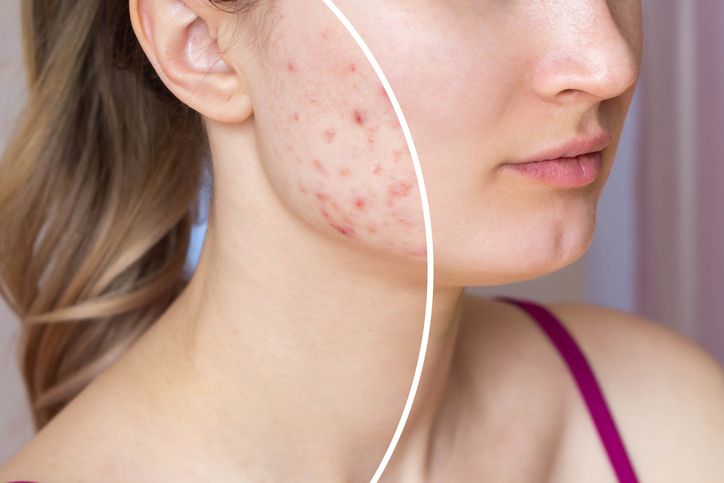
This skin's number one enemy can be categorized into a few types: whiteheads, blackheads, papules, pustules, nodules and severe acne or cystic acne. Whiteheads happen when the sebaceous glands are clogged with dead skin and sebum, forming a closed bump on the skin.
Sometimes known as comedones, whiteheads can appear white or yellowish. Another type of comedones is blackheads. Unlike whiteheads, blackheads are open bumps on the skin. They will look like dark spots on the skin.
Papules; the cause of your bumpy skin
Another type of lesion on the skin is an abscess, a raised area of skin tissue that is less than one centimeter round. An abscess can be in various shapes, colors or sizes. Different from bumps, which is a bulging patch of skin that is filled with yellowish fluid called pus. It will generally be seen as bigger than other types of adult acne. This condition occurs when your body is trying to fight off white blood cells. The pus results from infected fluid and dead white blood cells. Acne vulgaris is an inflammatory disorder of the pilosebaceous unit which happens when the hair follicle is clogged.
Acne development can be a pain and pull down one's self-esteem, who is cautious with their appearance. Getting into details about what causes acne can be subjective. However, the main reason would be excess oil production, bacteria and inflammation.
What can be the cause of your acne formation?
Acne can be triggered by hormonal changes during teenage life or midlife, particularly in women. Hormonal acne often occurs during menstruation or the menopause phase. It is possible for someone who consumes specific medication that contains corticosteroids or testosterone will cause their acne to be in severe form.
Alongside what you consume, for example, food that is rich in carbohydrates can be the factor that makes your acne much more active. Stress does not directly cause acne, but it can make it worse.
Acne myths that you should know
We often hear certain myths about acne, which are that chocolate and greasy food will trigger acne production. This does not correlate, although it affects your body weight.
Does makeup clog your pores?
Someone may say that wearing too much makeup can suffocate your skin. However, your skin will be delicate with the proper aftercare of obliterating the makeup. Never sleep with your makeup on, as this will clog the pores.

2
What causes acne to leave a scar
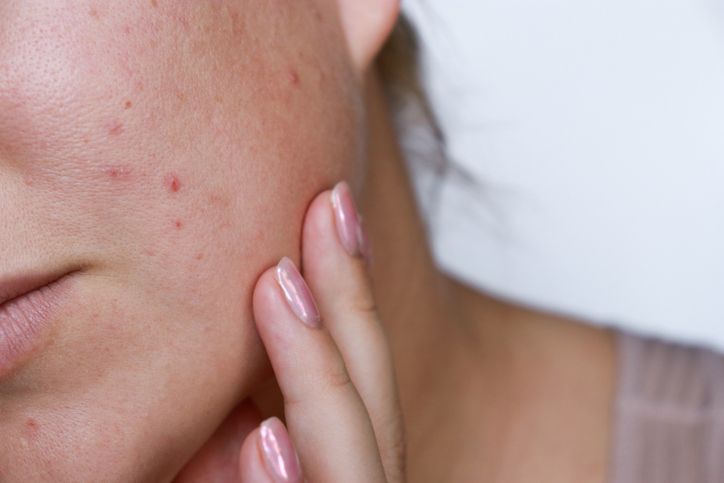
Any acne can cause scarring, especially when you pick or pop pimples. Acne scars can be categorized into three main types: ice pick scars, rolling scars and boxcar scars.
Type of scar that you should be aware of
Ice pick scars are the small and deep holes on the surface of your skin that look like the skin has been punctured with a sharp object. Meanwhile, rolling scars give the appearance of rolling and uneven skin.
Boxcar scars; a wound healing that will never go back the same
Boxcar scars are normally round and craters in the skin. Treating acne scars can be much different than treating acne, as it will take much longer.
Don't mistake your dark spots for acne scars.
Dark spots can be caused by acne, but it is not classified as acne scars. Instead, it will be treated like hyperpigmentation to the skin. It is undeniable that everyone wants to live with healthy and clear skin. To achieve that, one must get close to their acne. You must know what your acne type is, what is causing them, and what your skin type is. This is because acne treatment works differently with every skin. Every active ingredient also works differently on each skin.
Read More

3
Get to know your skin types to start your acne treatments.
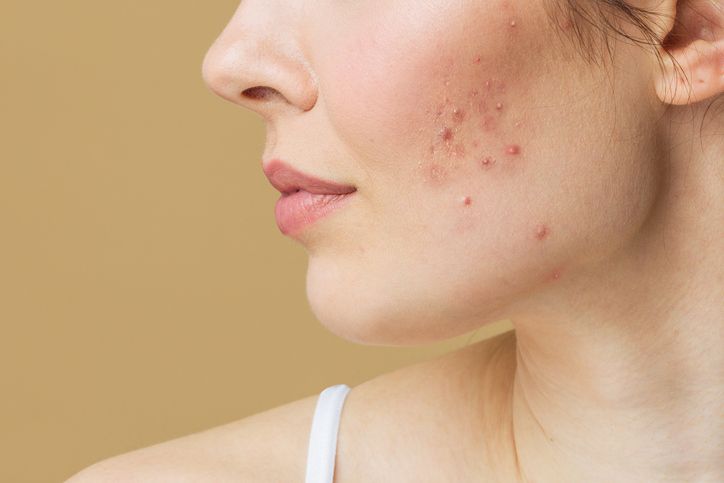
All skin types have different needs, and you can get to know them through simple observation. There is no "one size fits all" approach when getting to know what is best for your skin.
For instance, if you have oily skin, you will appear shiny and feel greasy, especially throughout the T-zone. The T-zone includes the forehead, nose and chin.
Oily skin is a way your skin screams for hydration.
Although people with oily skin tend to have fewer wrinkles, they are more prone to enlarged pores. The skin will continue to produce its natural oils but still require moisture.
How to deal with oily skin?
You must find the right products to give you enough hydration without clogging the pores. Usually, a lightweight, oil-free and noncomedogenic moisturizer can provide your oily skin the hydration that it needs. Oily substances like essential oils will only worsen the skin's condition.
Dry and tight skin, a condition where your skin requires more than just moisturizer
They generally produce fewer natural oils for dry skin than other types of skin. Unlike oily skin, they will appear dull and become rough and flaky. It will feel tight and have less elasticity which is caused by dehydration. A skincare routine for dry skin should include gentle, soothing and hydrating ingredients like hyaluronic acid, which can help to maintain the skin's appearance.
A blessing that most people do not notice until they lose it
Some are blessed with normal skin which is balanced-feeling neither dry nor oily. People with normal skin are typically not prone to acne, but they must maintain a good skincare routine.
Combination skin, a bit of both world
Another type of skin is the combination, which includes dry and oily skin. However, they can tend to be more on either side. They will vary according to hormones, stress or environmental factor. To tackle this type of skin, maintain a good skin moisture level.

4
Sensitive skin is a condition that you need to treat delicately.
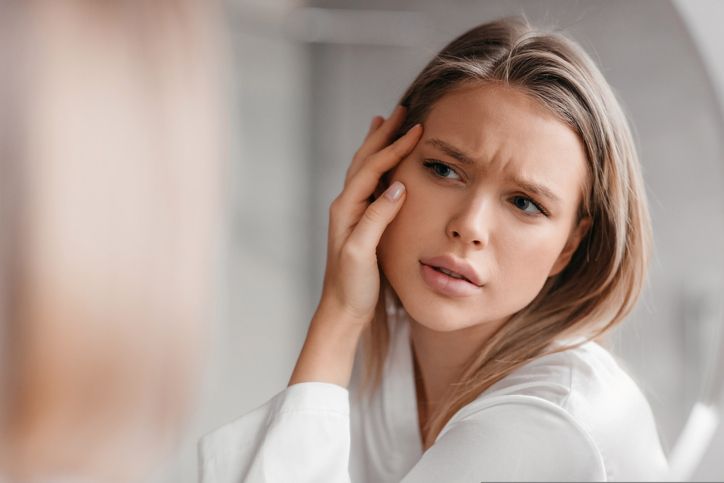
Lastly, the skin category is the sensitive skin type. If you have red, itching or dry skin that is possibly irritating if you are using any new products, you may fall into this category. You must know that your skin is sensitive to what type of products by doing a patch test before using a new product all over your face.
What to do first before starting to treat acne at home?
To identify your skin at home, you can do the "watch and wait" method, which after cleansing your face, pat it dry and wait for 30 minutes. If your skin appears shiny, you are most likely to have oily skin. If your skin feels tight, then you are on the dry skin side. If your face is only shiny on the T-zone, you probably have a combination skin type. You may be blessed with normal skin if your skin feels hydrated and comfortable.
Acne treatment: Where to start?
After getting to know your skin conditions, you can identify which skincare ingredients you can look for. The three main steps for good skin care are cleansing, treating and moisturizing. The store has thousands of serums and creams packed with beneficial skincare ingredients like retinol, niacinamide, alpha arbutin or vitamin C. You must bear in mind that no skincare works like magic. Every step needs consistency and only gives the results after some time.
How long should I expect for skin improvement?
Some may take 4 -12 weeks before the skin shows any improvement. Starting acne treatment at home means disciplining yourself to be consistent.
Which skincare routine that you need to follow to reduce acne?
The famous skincare steps contain a few variations, such as the seven-step or Korean skincare method. Finding the best skincare routine for you can be undertaken as it requires a lot of trial and error. There are no right or wrong steps in doing your skincare routine.
Double cleansing method; double the action of facial wash
The most common skincare routine starts with cleaning your face. Use a gentle facial cleanser that does not strip off your skin's moisture and massage in a circular motion. For those who love to wear makeup, make sure you use the double cleansing method. This method starts with a cleanser that can remove makeup, like micellar water, cleansing oil or remover wipes. After removing the makeup, you can continue the second cleansing using a gentle cleanser. Everyday cleansing is needed even if you do not wear makeup because dirt, particles and soot are everywhere.

Book Now to Experience
Acne Treatment
1 Minute Self-Registration
Date should not be before minimal date

5
Careful not to cause skin irritation with unnecessary usage of cleansing tools
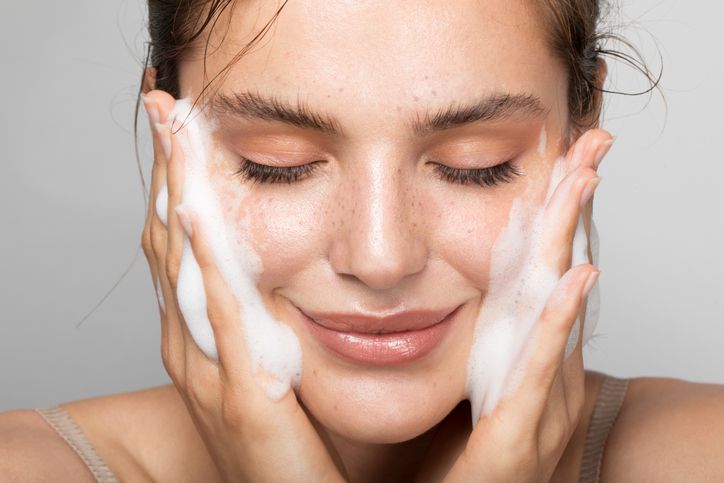
It is unnecessary to use any other tools other than your hand, but some people love to use brushes or electronic devices for a more thorough cleaning process. Choosing suitable tools for your skin type is essential, as some of them may be a bit harsh. However, the use of cleansing tools can cleanse clogged hair follicles.
Toner is a skin savior that provides multiple benefits.
Next, you can apply toner by pouring drops onto your palms or a clean cotton pad. It is best to know your toner's purpose, as it can be exfoliating or hydrating. Toners consisting of glycolic or salicylic acid can be used as physical exfoliators, which should never be combined with retinoids. It is a popular option to have acidic products for darker skin tones to keep the skin clear.Hydrating toner can contain hyaluronic acid and is best used by patting them to the in. Adding moisturizing products aside from your moisturizer is essential to reduce inflammation.
Serum, a necessity for your skincare routine
The serum works best according to its specific function according to its active ingredients. For instance, vitamin c serum can help to smooth out fine lines by plumping the skin texture. Vitamin C serum also helps to reduce the appearance of under-eye circles and fade hyperpigmentation aside from being hydrating. Your skin tone can be improved, and radiant skin will result from consistently using the suitable serum.
Eye cream; does it work?
The other step that is quite extra to some is applying eye cream. Some experts claim that eye cream is just a moisturizer in disguise of a smaller tube and a higher price. However, it is undeniable that your under-eyes need thick moisture to keep them hydrated.
Spot treatments; the ultimate and fast weapon to treat acne
Spot treatments are often used at night when your body is in repair mode. Be careful to use acne-fighting ingredients like benzoyl peroxide or salicylic acid with retinol.
Benzoyl peroxide helps to reduce pimples and bumps.
Benzoyl peroxide products are used to treat mild to moderate acne, which works by reducing acne-causing bacteria. Targeting the exact spot of acne can be an effective treatment without affecting the other part of the skin. This can cause skin irritation instead of getting rid of the acne. Spot treatments work wonders and sometimes stunt acne growth. Spot treatments can be too strong if applied too much as they have stronger active ingredients.

6
Sunscreen; is an essential step you should never forget
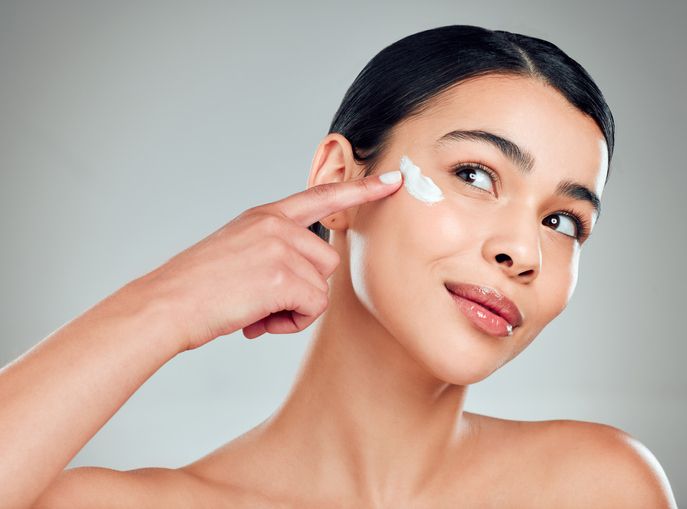
Next, you must never forget your sunscreen. Sunscreen formulas vary, so you need to look for broad-spectrum SPF that can protect your skin from UV rays. Sun exposure, which contains UV rays, is responsible for skin cancer and aging.
Type of sunscreen you should know
There are two types of sunscreen that you should look out for, physical and chemical sunscreen. Physical sunscreens sit on top of the skin and reflect the sun's rays, while chemical sunscreens contain active ingredients that absorb into the skin and absorb UV rays, convert the rays into heat and release them from the body.
Korean skincare; a regime that influences the world
Another famous skincare routine among youngsters is Korean skincare. Most models are portrayed as having glass skin. Glass skin is commonly used to refer to an intensely hydrated skin with minimal skin texture. A bit different from the Korean skincare regime, or some may refer to it as Kbeauty skincare. Mainly the products will originate and be manufactured in Korea. Korean beauty regimes are built for the long term as it requires consistency. Koreans introduce multiple steps routinely, and although it is time-consuming, they live by this method.

7
Ten steps Korean skincare routine
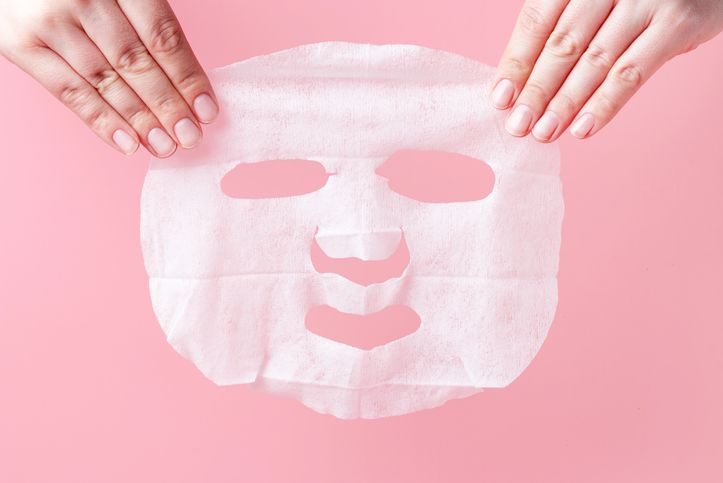
Among the famous routines is the 10-step routine, which starts with using an oil-based cleanser. As oil's properties repel from water, it is believed that oil can remove oil-based impurities from your skin.
Cleanser
Oil cleanser will not strip the natural oil from your face but can remove excess sebum that can clog your pores. Next, they will proceed with another face cleanser which usually comes in liquid or foam form.
Exfoliant
Exfoliants like scrubs and pads with chemical exfoliators can remove dead skin cells in the surrounding pores but can be harsh to specific skin types and susceptible skin.
Toner
Toners can usually be categorized into various types; some toners give hydrating functions, while others can act as exfoliating products. Toners are supposed to restore the balance of your skin's moisture.
Essence
This is a bit of the extra steps from the normal skincare routine. By layering your skincare products from the lightest to the thickest, you can achieve skin with the perfect moisture level. Essence is usually formulated with fermented ingredients, which are supposed to be used after toner and before serum.
Treatment
For these steps, they will focus on helping the skin's issues because the product will be packed with highly concentrated ingredients. They target acne like benzoyl peroxide or wrinkles like retinoids and work as spot treatments.
Sheet mask
Sheet masks have been such a hype all over the skincare industry ever since they made their debut. Almost everyone values their time wearing a sheet mask as the time when they pamper themselves. The serum-soaked paper will lie on your face for 15 to 20 minutes, and your skin will absorb all the good stuff.
Eye cream
A cream that targets fine lines, wrinkles, puffiness and dark circles. As we hit adulthood, moisturizing ingredients should be our best friend to fake a whole night's rest.
Moisturizer
This product locks in every other hydrating ingredient you have put on your skin. Acting as a sealant, you should find out what type of moisturizer is best for your skin, depending on its condition.
SPF
Like any other skincare routine, sun damage should be avoided as it can cause pigmentation, so do not forget your sunscreen.

Book Now to Experience
Acne Treatment
1 Minute Self-Registration
Date should not be before minimal date

8
Home remedies; make everything at home works
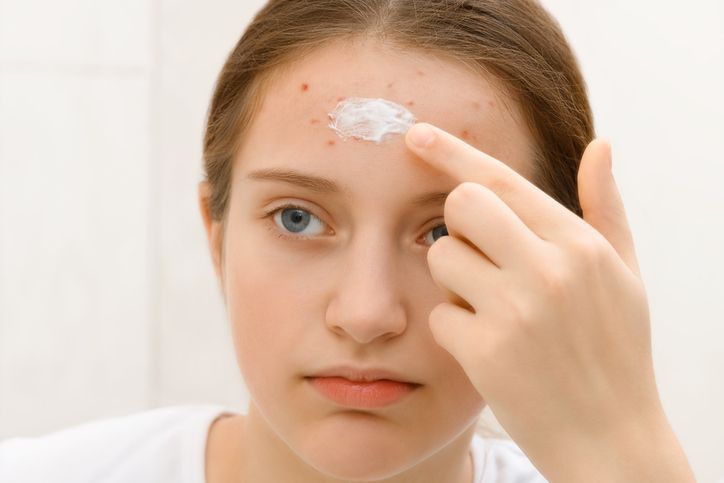
Home remedies like natural ingredients on your skin can also help improve your skin texture. And get rid of the acne. For example, soothing ingredients like aloe vera or green tea can be used as a face mask.
Coconut oil as your scrub ingredients
You can use coconut oil and mix it with sugar to create a scrub but be careful of coarse texture that will cause skin irritation. However, it would help if you found out what skincare will not irritate the skin, like witch hazel or essential oils.
Witch hazel helps to repair your skin barrier.
Witch hazel contains active ingredients called tannings, which, when applied to the skin, can reduce swelling and help repair broken skin, which can be a bit harsh to sensitive skin.
Tea tree oil is a popular choice to treat acne.
Due to its anti-inflammatory and antibacterial qualities, tea tree oil is a popular alternative for treating acne. It is said to reduce inflammation, edema, and redness. You could get smooth, clear skin by preventing and reducing acne scarring. Acne-prone skin can be tamed by having a proper and soothing skincare routine. Providing enough moisture and hydration will reduce the possibility of clogged pores. Among a few methods of treating pimples you can do at home are do-it-yourself masks. You can combine ingredients with antibacterial properties with soothing properties and pamper yourself.
Exfoliation keeps the skin smooth and clean from dead skin cells.
Exfoliation also can be done at home to remove dead skin cells. You should be aware not to overdo it for physical exfoliation, like using scrubs. Some products contain active ingredients like AHAs, BHAs and retinoids for chemical exfoliation. It would help if you had a time gap before the following exfoliation process. Other treatments to prevent acne, like light therapy, over-the-counter medications, and prescription medications, can prevent future breakouts. Acne medication can be beneficial to clear out mild acne and moderate acne; however, you should opt for a healthier solution.

9
Although it seems like a lot of work to fight your acne, you must keep going.

With all the steps and tips you need to follow to fight your acne, several dos and don'ts help you achieve better results. Firstly, do not use a mild non-abrasive cleanser when you have severe acne.
Maintain your skin's moisture.
Do not overdo your face wash, although it is lovely to have squeaky-clean skin. You may make things even worse by stripping off your skin's moisture.
Be careful with the sun's exposure.
While there is some evidence that vitamin D, which you can receive from the sun and some foods, has antibacterial effects and can help reduce inflammation, spending excessive amounts of time in the sun is terrible for your skin and can cause acne. It might make you more susceptible to skin cancer or sun damage. Make sure you consume enough vitamin D in your diet or through supplements if your sun exposure is restricted, such as during the winter. Some anti-acne drugs may also increase your sun sensitivity. You should see if your acne medicine has any cautions on it.
You are what you eat, and your skin will show the results.
While the hamburger and chocolate bar won't cause acne, a poor diet won't prevent it. Drink plenty of water throughout the day to stay hydrated, and follow a balanced diet full of lean proteins, fruits, and vegetables. Limit your intake of sugars and carbohydrates, and stay away from liquids that have been sweetened or artificially sweetened.
Don't stuff your face with heavy makeup just to conceal your acne.
It is not advisable to use makeup to cover imperfections. "Many people with severe acne use cosmetics to cover it up, but this leads to a vicious cycle where more makeup clogs pores and causes even more acne. When feasible, try to apply as little as possible and wipe it off carefully from your acne-prone skin.
Keep your phone clean
Nowadays, cell phones resemble yet another part of our bodies, especially for tweens and teens. Although we've already covered the problem of excessive technology use, your phone can also house bacteria, including the kinds that cause acne. Make careful you clean your phone frequently. Nevertheless, it is possible for a self-skin diagnosis as you will know yourself better, but you will always need a patch test before trying out new products.

Book Now to Experience
Acne Treatment
1 Minute Self-Registration
Date should not be before minimal date
Recommended Articles
COPYRIGHT© NEW BEAUTY MANAGEMENT LIMITED 2025. ALL RIGHT RESERVED.

